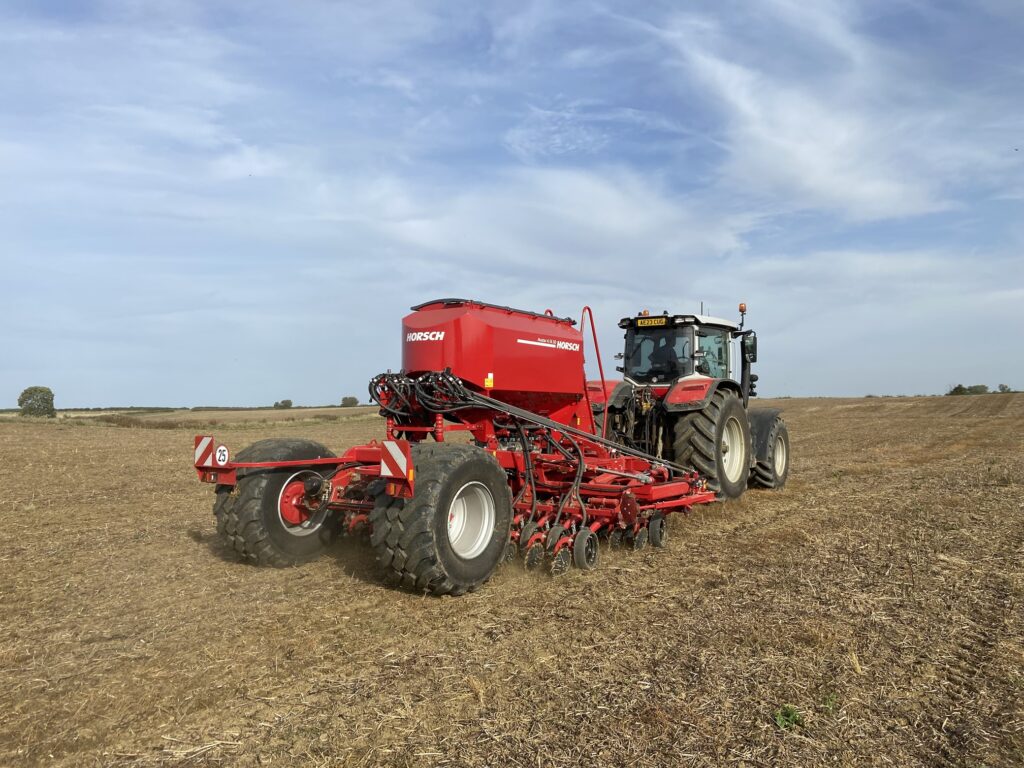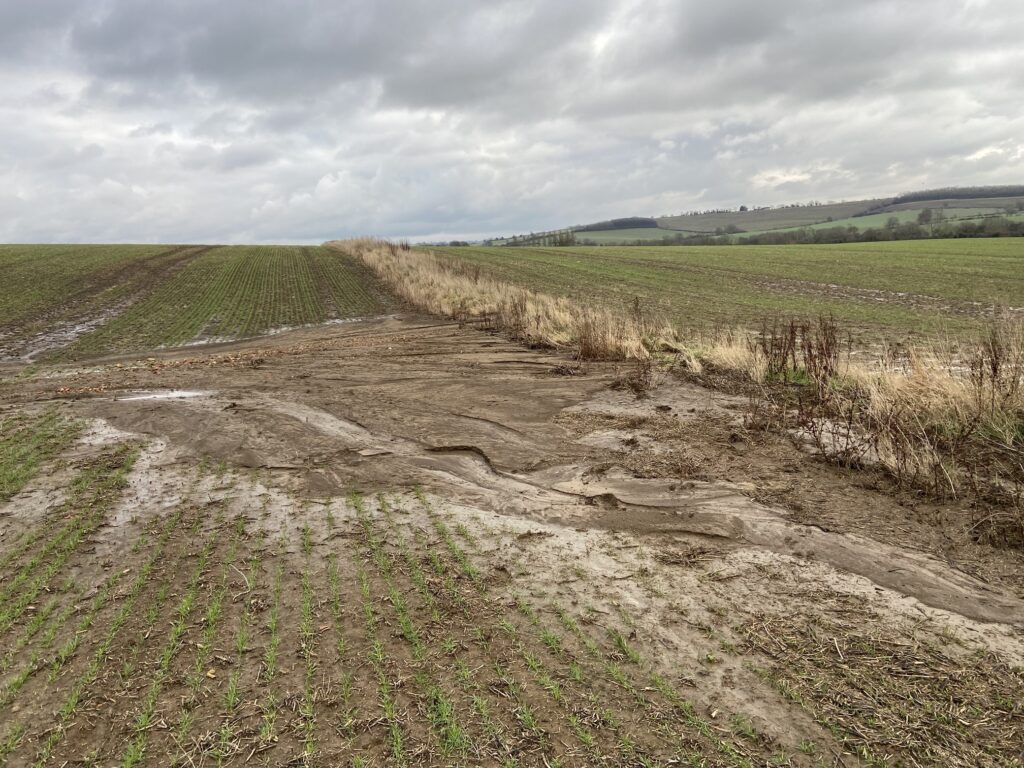Written by Joe Stanley
As I write this in the third week of March, I can reflect on challenging times both behind and ahead. On the heavy Hanslope-Denchworth series clays of the Allerton Project, we are yet to get so far even as to have terminated our cover crops, let alone apply any spring inputs to those autumn-sown crops which have survived the onslaught of one of the wettest winters on record – though we judge that only some 35% of our winter wheat area is even salvageable. Even were the incessant rains to cease today, we are likely looking at planting our wheat, beans, oats and barley well into the middle of April, significantly compromising potential.
In my view, extreme weather has been persistently afflicting agricultural operations in the UK since at least the summer of 2018; initially whole seasons began to oscillate to extremes, but more recently seemingly every month brings new weather records of one sort or another. From September 2023-February 2024, Allerton has recorded 626mm of rainfall (including the wettest February since records began in 1836) which already takes us to our median average annual total. I’ve no doubt that come May and June, we’ll be experiencing another extended hot, dry spell.
Here at Loddington, we have been focussing on soil health and resilience for two decades, undertaking the transition from inversion to reduced tillage, and finally to pure ‘direct drilling’ (where appropriate) culminating in the purchase of a Horsch Avatar for our autumn campaign last year (a journey outlined by our director, Dr Alastair Leake, in Direct Driller issue *[1] last year). We have ample data to demonstrate the benefits (all things being equal) of this transition, both economic and environmental.[2] However, despite the enthusiasm with which he have embraced this journey, our experience of recent years – and especially the last twelve months – is leading me to question whether the climate mitigation measures which I expounded in the last issue of DD[3] are any longer sufficient to build the levels of field and soil resilience required to endure the extremes of weather with which we are now faced.

In spring 2023, central and southern England experienced some 200% of normal rainfall, which delayed our own drilling campaign (interrupted the previous October by rain) until the final week of April and into early May. Clearly, beans and wheat planted so late in the season were always going to need a fair wind behind them to turn a profit; alas, May and June saw some 20% of normal rainfall and it was not to be. Final yield was correspondingly disappointing, with the anaemic spring beans not being cleared until the second week of October. Wheat subsequently direct drilled mere days ahead of Storm Babet (which dropped 65mm of rain in 24 hours) and the eight subsequent named storms to date has, as reported above, not thrived.
Twelve months on, we look to be facing the same situation once more: the prospect of late-drilled, thin crops with poor agronomic performance and negative gross margins. However, for the ground originally earmarked for winter (then spring) beans, this season we don’t intend to take the same risk again, instead planning to plant a summer fallow allowing us a good entry into wheat this coming autumn. Working alongside our seed partner, Kings Crops, this will also give us good insight into the potential for the new SFI summer fallow option to be available from next year.

Another aspect of last winter’s extreme rainfall has been unprecedented levels of soil erosion across the estate. Once again, despite a long focus on conservation (and more recently regenerative) agriculture and measurable improvements in soil health, the level of soil damage (exacerbated by late-planted, unplanted or failed winter crops) has been terrible to see – and the value of well-established cover crops never been better demonstrated. In a ghoulish way, I am looking forward to seeing the results of lidar scans and soil sampling undertaken on our most impacted fields which will give us a monetary value of the soil and nutrients lost over the course of the winter, data which we will share with our 2,000 or so annual visitors to help focus minds on the importance of soil protection.
Yet the question remains – on our rolling slopes and grade 3 marginal land, and in the absence of direct payments, can we continue to weather the extreme conditions which are likely only to intensify in their effects? Or might more dramatic resilience-building measures be required?
The Allerton Project has commissioned work looking at what might be necessary in our wider catchment to meet government targets under the 25 Year Environment Plan to reduce nitrogen, phosphorous and sediment pollution from agriculture into water by 40% by 2037. The modelling suggests that (in a silty-clay/silty-clay loam landscape with relatively steep topography) some 47% of land currently in arable production would need to be put to other land uses to meet those targets (a retasking of some 1300ha). This would include afforestation, arable reversion to grassland and much more extensive use of buffer strips. The modelled production loss would be some 10,500t of wheat/year.
These targets are, of course, national and not on the individual farm or catchment level, but nevertheless our figures indicate the potential scale of the transition required in a challenging landscape such as ours – especially as winter rainfall becomes ever more intense. As financial options to enact such land use change become more attractive – whether from public or private coffers, or a combination of the two – farmers can hardly be forgiven for considering them, given the experience of recent years of trying to grow profitable commodity crops traded at wildly fluctuating global prices with stubbornly escalating input costs.
Indeed, at my own home farm near Loughborough in Leicestershire, the driving motivation behind entering a Mid-Tier stewardship agreement in 2021 was climate change: I had had enough of seeing arable soils disappear downslope during wet winters, and crops wilting and dying on our lightest land. Fields that had happily been in arable production for decades were placed in a mixture of legume fallow (AB15) and diverse herbal leys (GS4). I have seen nothing since to make me think I made a poor choice in so doing.
I think that many farmers will be facing an increasingly difficult choice in the coming years as to whether they persist with their current methods of production, or take advantage of novel income streams to significantly alter the dispositions of their holdings. Ironically, perhaps, given the current zeitgeist around ‘plant-based diets’, it’s actually in grazed pasture that the safest agricultural land use can be found.
It seems unfortunate that, just as momentum is beginning to build around a significant transition to more sustainable arable production methods which focus on the laborious task of improving soil health, the weather is making that transition more challenging than at any time in living memory (and perhaps the past few thousand years). Indeed, one of the significant observations we’ve been able to make this winter at Allerton is that, in our long-running cultivation comparison fields, our ploughed plots have survived the rain in far better condition than those that have been direct-drilled! Although a transition away from inversion tillage is an essential element of improving soil health, there’s no denying that the route to more sustainable production is neither straight nor simple!




